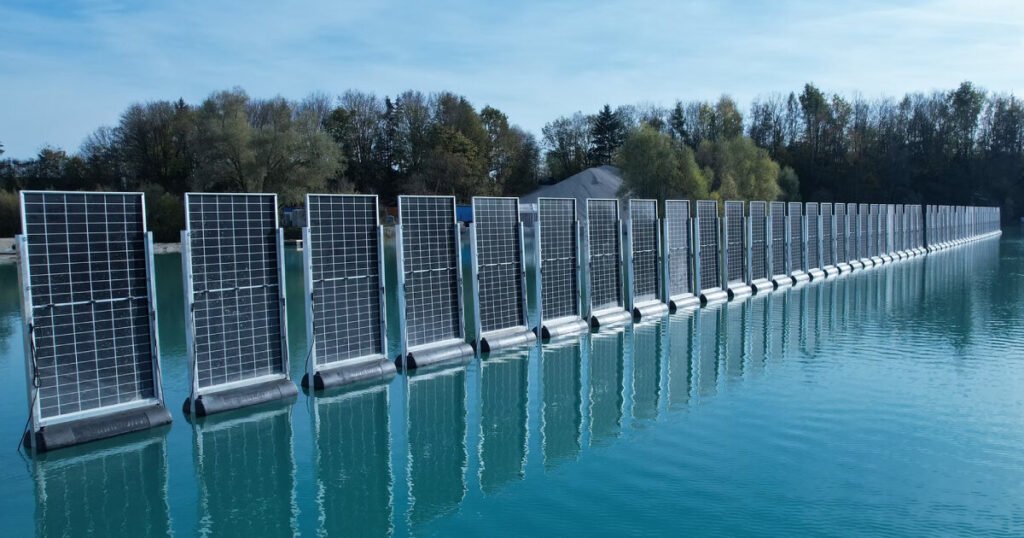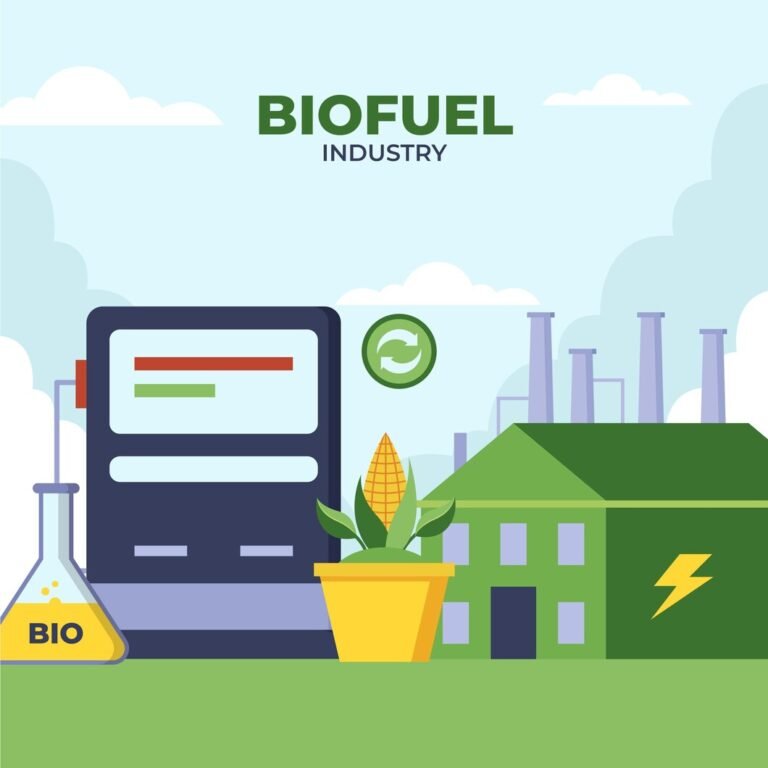Vertical Floating Solar Panels Could Let Fish Farms Harvest Electricity Too
When you picture a fish farm, you probably imagine tidy rectangular ponds, silver flashes beneath nets and workers checking water clarity at dawn. Now imagine those same ponds with rows of solar panels rising up — not flat across the water, but arranged vertically on light floating frames or along pond edges — catching morning and evening light while leaving most of the pond surface and daily rhythms of farming intact.
That idea is moving fast from sketches and lab experiments into large projects and pilot farms around the world, because it promises to solve two pressing problems at once: farms’ rising energy bills and the demand for clean electricity on crowded land. According to a U.S. Department of Energy / NREL overview, floating photovoltaic systems and “AquaPV” (solar combined with aquaculture) can lower energy costs at farms, reduce evaporation, shade ponds from extreme heat, and generally strengthen local food-and-energy security.
This story is not hypothetical. In Taiwan, mainland China, and parts of Europe, firms and researchers have installed floating arrays on pond systems and reclaimed coastal ponds, and multinational suppliers are sizing up inland fish farms as places to build very large floating solar arrays. One industry account by Clean Technica describes a 940-megawatt floating array being supplied to a fishery complex in East China — a project the manufacturer billed as both a renewable power station and a living laboratory for aquaculture-solar integration.
That scale-up has sparked a second, urgent conversation: what happens under the panels? Growing evidence from experiments and field measurements shows floating and pond-covering PV can change water temperature, oxygen levels and greenhouse-gas dynamics — sometimes for the better, sometimes not. A 2023 scientific lake study found that heavy coverage by floating arrays reduced sunlight on the surface and altered thermal stratification in ways that could mitigate summer heat stress in some lakes, but will also change the lake’s internal circulation and ecology.

In This Article
- How Vertical Floating Solar Works
- Real-World Tests and Trade-Offs
- What Farmers, Regulators, and Investors Should Do Next
How Vertical Floating Solar Works
“Vertical” in this context means panels or bifacial modules mounted upright (or near-vertical) on floating frames, or fixed along pond berms and cage edges rather than lying flat above the water surface. Vertical layouts can slice shading down to narrow bands instead of a blanket, freeing more surface area for fish movement and feed operations. They also change the timing of electricity production: vertical bifacial modules tend to produce more in the morning and evening because they can capture light reflected off water on both faces, smoothing daily power curves for farms and nearby grids. Recent engineering papers and demonstration projects show vertical bifacial designs can outperform certain conventional arrangements in some climates and, crucially for aquaculture, reduce the total shading footprint while still producing useful energy.
Vertical mounting has other practical advantages for fish farms. In open coastal or cage-based aquaculture, modules can be attached to the edges of floating fish cages or to reused cage frames, converting existing infrastructure into energy platforms without building heavy new decks. An earlier engineering concept for offshore combined wind–solar–aquaculture even proposed using the fish cage itself as a structural base for turbines and solar arrays — a reminder that the idea of “solar plus fish” has dozens of technical variants, from pond-cover modules to vertical, cage-mounted arrays.
Real-World Tests and Trade-Offs
Farmers and researchers who have tried aquavoltaics (aquaPV) report a mix of clear economic benefits and complex environmental trade-offs. On the one hand, shading from panels can reduce water temperature on hot days, lowering stress on heat-sensitive species like shrimp and some finfish and cutting evaporative water loss — a huge win in dry regions where water is scarce. The NREL overview highlights these operational co-benefits and argues that, by replacing diesel pumping and aeration, solar can significantly lower operating costs at remote and off-grid farms.
On the other hand, controlled experiments show the picture is not uniformly positive. In the first manipulative, ecosystem-scale field experiment to test floating solar, researchers covered ponds with representative floating arrays and tracked greenhouse-gas fluxes, dissolved oxygen and other indicators. The study found greenhouse-gas emissions from those ponds rose by about 27% compared with uncovered ponds, and dissolved oxygen levels dropped — changes that can stress fish and alter pond ecology if not carefully managed. Cornell University’s coverage of the experiment highlighted that these emissions and oxygen shifts appeared quickly after installation.
The 2023 lake study measured a 73% drop in surface irradiance under an FPV installation and detected measurable changes in stratification and wind patterns above the water; the researchers emphasised that impacts depend strongly on coverage percentage, local climate and pond depth. In short, shading can cool summer surface temperatures and potentially reduce algal blooms, but it can also lower oxygen in some conditions and change nutrient cycling, which matters for both fish welfare and greenhouse-gas balances.
Those trade-offs are why many engineers are drawn to vertical or low-cover designs: they aim to keep the benefits of shade and local electricity while limiting continuous coverage that causes low-oxygen “dead zones.” According to PV Magazine, one recent development is PVSail and other rotating or vertically oriented floating systems that re-align with wind to reduce wave loads and present much less continuous shade across a waterbody, yet still harvest reflected light on both faces of bifacial panels. Field pilots and modelling suggest these approaches can split the difference between energy yield and ecological impact — but they are new, and long-term monitoring is scarce.
Farmers’ stories underline the mixed reality. In Taiwan — where land is short and fishponds are abundant — projects have been built that place panels along pond edges and over portions of ponds so that energy revenue helps finance more resilient farming equipment and automate feeding and aeration. Operators there report fewer bird predation losses and stable income from selling surplus power, but they are also watching water quality closely and adjusting panel density to protect juvenile fish. These are real, practical trade-offs a fish-farm manager learns to balance each season.
What Farmers, Regulators, and Investors Should Do Next
If you run a fish farm and are curious about vertical or floating solar, treat it like any other technology that touches living systems: start small, monitor closely and plan for adaptive management. First, don’t assume a one-size-fits-all coverage rate will work. Research and field pilots show that coverage percentage — the fraction of the pond surface shaded — is a dominant control on temperature, oxygen and greenhouse-gas responses. Design systems to allow staged coverage increases and robust monitoring of DO, temperature and GHG fluxes so you can stop or modify the layout if early warning signs appear. The 2023 report by NREL highlights the need for demonstration areas and community outreach to build trust and gather the environmental evidence that regulators will eventually require.
Second, favour flexible designs that let you tune shading across seasons and life stages of stock. Vertical or edge-mounted bifacial arrays — and floating systems that rotate or present smaller shadow footprints — give managers levers to reduce continuous shade while still producing usable energy during key hours. Engineering groups and pilots such as those developing vertical, rotating floats have shared early results suggesting these installations can reduce structural wind loads and smooth daily output, which is valuable when you are running pumps and aerators on a tight schedule.
Third, plan business models that make the most of joint value. In several documented cases — from Taiwanese near-shore projects to Chinese fishery FPV projects — operators sell surplus electricity, use local generation to replace diesel, and reinvest revenues into automation and improved farm hygiene. Investors and cooperatives can lower individual farmer risk by pooling ponds into shared AquaPV zones and offering central maintenance and monitoring, a policy option NREL recommends in its regional guidance.
Fourth, regulators and funders should require baseline ecological monitoring as a condition for support. The strongest science now comes from projects that include before-and-after measurements and control ponds — that’s how researchers detected the greenhouse gas increase in Cornell’s experiment. Fund demonstration projects that incorporate high-frequency DO and GHG sensors, and mandate adaptive mitigation if negative trends emerge. The Scientific Reports lake study showed that different lakes respond differently to coverage and wind effects — and those variations are crucial for approvals.
Finally, for journalists, consumers, and policymakers: it’s important to see the full picture. Floating and vertically oriented aquavoltaics are neither a silver bullet nor a simple hazard. They are design-sensitive tools that can deliver clean power, conserve water, and increase farmers’ income — or, if deployed poorly, cause ecological stress in small, shallow, densely covered ponds. The right path is clear: more demonstrations, transparent monitoring, and business models that share both benefits and risks. The technology is young but promising; with careful engineering and honest oversight, it can transform many fish farms into small clean-energy hubs without harming the living systems they depend on.
Sources
- Badran, G., & Dhimish, M. (2024). Comprehensive study on the efficiency of vertical bifacial photovoltaic systems: a UK case study. Scientific Reports, 14(1). https://doi.org/10.1038/s41598-024-68018-1
- Zheng, X., Zheng, H., Lei, Y., Li, Y., & Li, W. (2020). An offshore floating Wind–Solar–Aquaculture System: concept design and extreme response in survival conditions. Energies, 13(3), 604. https://doi.org/10.3390/en13030604
- Ray, N. E., Holgerson, M. A., & Grodsky, S. M. (2024). Immediate effect of floating solar energy deployment on greenhouse gas dynamics in ponds. Environmental Science & Technology. https://doi.org/10.1021/acs.est.4c06363







